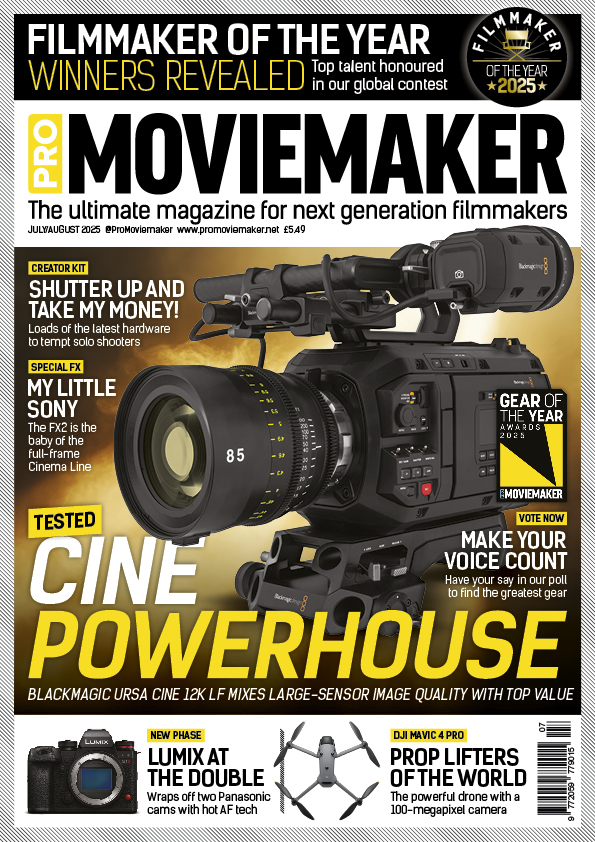
Hybrid Heroes
Posted on Sep 10, 2024 by Pro Moviemaker
Crossover cameras are now mainstream within professional filmmaking – and buying used from MPB saves you cash
Advertisement feature
Mirrorless cameras may have revolutionised the world of professional filmmaking with their large sensors and video spec. But most have some sort of compromise – from overheating issues to limited codec choices and dodgy handling.
Manufacturers are making far more video-centric versions of their cameras for serious movie work. And there are cameras that are now redefining what we think of as hybrids or crossover models.
However, these sell in smaller numbers than their typical mirrorless counterparts, and often have a longer shelf life in comparison rather than being upgraded every year. This means their prices usually stay high new, while finding them on the used market can be difficult.
Enter used gear specialist MPB – the equipment retailer that’s staffed by real experts. Buying used kit simply costs less, so you get much more for your budget. And MPB has stocks of hard-to-get models.
Making the move up to newer gear often means getting rid of your old kit, ideally for a great price, but definitely as hassle-free and safely as possible. With MPB, you can help pay for the gear you want by trading in the gear you no longer need. It’s quick, easy and secure – so much faster and simpler than trying to conduct a private sale from online auctions or classifieds.
MPB specialists test every single item based on 40 criteria to make sure they’re in reliable and working condition and have the latest firmware installed. But which hybrid makes a great buy right now?
Canon’s cinema superstars
The Canon EOS R5 C is based on the EOS R5 mirrorless camera, with its 8K full-frame sensor and Raw internal recording. Now the Canon EOS R5 Mark II is hitting the market, there may be more stocks of the R5 C.
This is a physically fatter version of the R5 as it crams in a cooling fan and has useful features like waveform monitoring and no limit on recording time – as well as file formats like 8K/60p Raw. It can shoot in 8K or high-quality C4K settings that downsample the 8K files for super-detailed 4K in up to 120p, for as long as your batteries and memory card last. The original R5 would quickly overheat.
But the in-body image stabilisation system is gone because Canon believes filmmakers will use a tripod or gimbal.
The EOS C70 is a different beast with a Super 35 dual-gain sensor in a body that has built-in ND filters, XLR inputs and large batteries for all-day shooting. It has the same Super 35 Dual Gain Output sensor from the EOS C300 Mark III cinema camera for 16+ stops of dynamic range, and records 4K 4:2:2 10-bit to internal twin SD cards in the XF-AVC and MP4 formats. Colour profiles include C-Log2 and 3 plus HDR.
The C70 uses the optical IS from RF lenses and digital IS in the camera body, which gives a slight crop. The body has 13 assignable buttons, a multi-function hand grip, professional input/output terminals including HDMI and two mini XLR for audio. There is no viewfinder and it boasts the traditional audio controls of a cinema camera hidden behind the flip-out, articulating touchscreen.
This is an ideal step up to real cine cam ergonomics with the features to combat the limitations of mirrorless cameras for video.
Sony’s special FX
Sony’s A7S III was once thought of as a cinema-focused hybrid model, until the FX3 came along. It features the internals of the A7S III in a more cinema-style body and is officially part of Sony’s Cinema Line series. Then came the FX30, basically an FX3 with a Super 35 sensor rather than a full-frame CMOS.
Both have lots of mounting points around the body so you don’t need to splurge on rigs. You can just bolt your top handle, monitor mounts or light right to the body to keep things as neat as possible.
These cameras are designed for shooting video in a 17:9 crop of the sensor, with some stills capability bolted on to allow you to shoot some thumbnails for your YouTube videos. For stills, there’s no AF tracking or continuous burst shooting, no electronic viewfinder or compatibility with external flash, and no uncompressed Raw files or AF illuminator.
With the cheaper FX30 offering things like 10-bit 4:2:2 All-Intra in 4K, this gives an immense amount of colour information, so makes grading far easier than if you use a less-intensive codec like 4:2:0 8-bit. Or, if you must have full-frame, the FX3 is it.
Panasonic boxes clever
While the Panasonic Lumix GH6 and S1H mirrorless cameras both pack in lots of filmmaking spec, the BS1H uses the fan-cooled dual ISO sensor and processor of the S1H in a smaller, box-style body that has more professional I/O options.
Compared to the S1H, in-body image stabilisation and any sort of screen have been axed. So, you have to either plug in an external monitor or link to the camera with your smartphone and use the free Lumix Sync app. Once you have put on an external screen, then set up the Wi-Fi or Bluetooth to communicate with your phone, you are good to go.
The BS1H is capable of incredible image quality in such a small and customisable package, so is ideal for use on a gimbal or drone. The camera has 11 standard threaded holes all around its rugged body, so you can pretty much mount it to anything – or bolt anything on to it.
It has 3G-SDI and HDMI connections as well as Ethernet, USB-C, 2.4GHz Wi-Fi connectivity and Bluetooth 4.2. The camera can simultaneously output 4:2:2 10-bit at 60p in HD from the SDI connection and 4K from the HDMI. One feed is perfect for live streaming, and another for recording in higher quality for editing later.
Rig it up as a cine camera, documentary camera, wireless remote camera, streaming device or even as part of a multicamera broadcast production.
Magic formula
The Blackmagic Pocket Cinema Camera 6K Pro may look like a massive medium format stills DSLR but is all about filmmaking with a Super 35 sensor, five-inch tilting LCD, built-in ND filters and XLR audio.
Although you can now get full-frame versions of the camera, the best-value is the original Blackmagic 6K Pro which shoots Blackmagic Raw files.
Its Super 35 HDR sensor has 13 stops of dynamic range and dual native ISO. It will shoot in 60fps from the full sensor or 120fps with a crop. It can record in 10-bit Apple ProRes in all formats up to 4K or 12-bit Blackmagic Raw in all formats up to 6K. These are recorded to a CFast card or externally to a USB-C drive, which is popular with Blackmagic users.
The one-shot contrast detection AF system doesn’t offer tracking and there’s no autoexposure or image stabilisation.
Dual native ISO, with base settings of ISO 400 and 3200, prioritises low noise. Recording is up to 6K in Blackmagic Raw format plus 3.7K anamorphic, and 2.8K in 17:9 plus 10-bit 4:2:2, at a range of ProRes settings in C4K, 4K or FHD. There is 120fps slow motion in either 2.8K 17:9 Raw or HD ProRes scaled from 2.7K, but the crop in 120fps is a severe 3.388x.
Whichever hybrid camera you end up choosing, you can’t go wrong buying it from MPB.
This feature was first published in the September/October 2024 issue of Pro Moviemaker.










